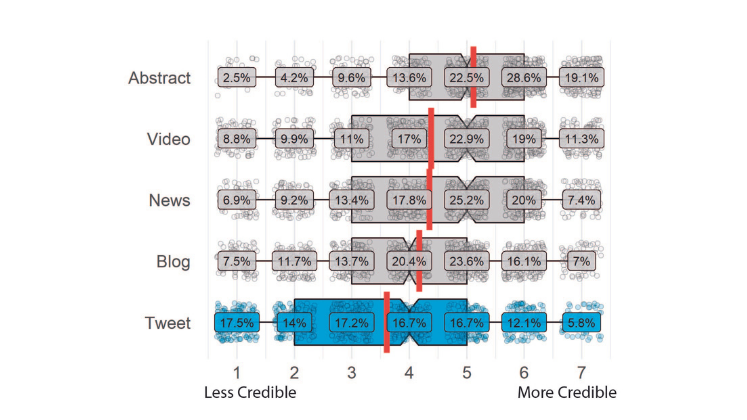 Previous research has shown that researchers’ active participation on Twitter can be a powerful way of promoting and disseminating academic outputs and improving the prospects of increased citations. But does the same hold true for the presence of academic journals on Twitter? José Luis Ortega examined the role of 350 scholarly journals, analysing how their articles were tweeted and cited. Findings reveal that articles from those journals that have their own individual Twitter handle are more tweeted about than articles from journals whose only Twitter presence is through a scientific society or publisher account. Articles published in journals with any sort of Twitter presence also receive more citations than those published in journals with no Twitter presence.
Previous research has shown that researchers’ active participation on Twitter can be a powerful way of promoting and disseminating academic outputs and improving the prospects of increased citations. But does the same hold true for the presence of academic journals on Twitter? José Luis Ortega examined the role of 350 scholarly journals, analysing how their articles were tweeted and cited. Findings reveal that articles from those journals that have their own individual Twitter handle are more tweeted about than articles from journals whose only Twitter presence is through a scientific society or publisher account. Articles published in journals with any sort of Twitter presence also receive more citations than those published in journals with no Twitter presence.
At the beginning of this year I wrote about how the participation of scholars on Twitter can influence the tweeting of their articles. Based on the results of previous research, I explained that research articles whose authors have a Twitter handle are more tweeted and, by extension, this fact favours their future citation impact. These results made clear that dissemination (as measured by tweets) is of great importance to scientific impact (as measured by citations), and so raised the question of to what extent citation impact is a reflection of dissemination rather than research quality.
Continuing along these lines, more recent research explores the role of journals on Twitter, analysing how their articles are tweeted and cited. 4,176 research articles from 350 scholarly journals were extracted from altmetric provider, PlumX. These journals were classified in four categories according to their engagement degree on Twitter:
- Journals with their own Twitter handle
- Journals without a Twitter handle but whose owner (professional association, scientific society, etc.) does have a Twitter account
- Journals whose only presence on Twitter is through the account of their publisher (Elsevier, Wiley, Springer, etc.)
- Journals with no presence of any type on Twitter.
After a log transformation and a time-normalisation of the Twitter accounts, the average tweets and citations received by these journals were statistically compared.
 Image credit: Tweet if you like the lights by Bex Walton. This work is licensed under a CC BY 2.0 license.
Image credit: Tweet if you like the lights by Bex Walton. This work is licensed under a CC BY 2.0 license.
Results showed that articles from journals with their own account are 46% more tweeted, on average, than articles from journals without a Twitter account; 36% more than articles from journals with an owner account; and 25% more than papers from journals with a publisher account. However, looking at citations, the most significant variation was found regarding papers from journal and publisher accounts, which receive 34% and 32% more citations, on average, than papers from journals without a Twitter account. This result again demonstrates the strong relationship between dissemination and citation impact, emphasising that the diffusion of research findings on Twitter will improve, in the long run, the number of citations academic outputs receive.
But the mere presence of journals on Twitter is not enough to understand the way in which the dissemination on that social network favours the tweeting and citation of research papers. What type of action is more influential in the success of a research paper on Twitter? A regression analysis was performed to estimate the effect of the social networking metrics (e.g. number of tweets, followers, and followings) of a Twitter account on the academic impact (citations) and dissemination (tweets) of their research papers. Results found that followers is the only variable accepted in the model (β=.47), suggesting that the number of followers has a positive effect on the number of tweets that a paper receives. Particularly, an increase of 10% of followers might cause Twitter mentions to grow by 4.7%. As we can see, the required effort to increase the number of followers is too much (more than the double) and not worth the benefits. In addition, the fit is poor (R2=.46) and therefore the effect is only perceptible for less than the half of the journals. Even so, this result emphasises the power of the network of followers to the successful spreading of information on Twitter.
Looking at the number of citations, regression analysis found even weaker relationships. The number of followers by year is again the only variable that influences the number of citations an article receives. But now the coefficient is smaller (β=.283), and the fit is poorer than in the case of tweets (R2=.18).These findings tell us that activity on Twitter has less influence on citation impact. The model suggests that a 10% increase in followers would produce only 2.8% growth in citations. This percentage is better (3.4%) if only journals with their own Twitter handle are considered. This result provides yet more evidence that the effort of maintaining a large network of followers is not enough to improve citation impact of one’s research papers.
In conclusion, these results make clear that the institutional presence of research journals on Twitter is fundamental for the dissemination and visibility of their outputs. Journals should consider Twitter as an important instrument for broadening audiences and tracking the social media impact of their publications. Furthermore, these findings suggest the best strategy to promote academic journals on Twitter is to have an individual account devoted exclusively to disseminating the journal’s content. Publishers and scientific societies should take heed and go to the effort of creating specific Twitter accounts for their journals. This would have the benefit of providing clear identification of the journal and track, in detail, social media engagement and impact of their publications.
From a research evaluation point of view, these results might suggest that journal activity on Twitter can affect the number of tweets and citations its papers receive. However, these results should be interpreted in term of dissemination, in which the broadcasting of research outputs has an impact on a specific audience of researchers that use that information for future studies. The more an article is spread over social networks, repositories, blogs, news sites, etc., the bigger audience it reaches, increasing the likelihood of it being cited by colleagues. This being the case, these results should be used by publishers to inform efforts to improve the discoverability of journals and not with a view to assessing quality or academic impact. The number of mentions on Twitter should be understood as a dissemination metric, not as a scholarly impact indicator.
This blog post is based on the author’s article, “The presence of academic journals on Twitter and its relationship with dissemination (tweets) and research impact (citations)”, published in the Aslib Journal of Information Management (DOI: 10.1108/AJIM-02-2017-0055).
Note: This article gives the views of the author, and not the position of the LSE Impact Blog, nor of the London School of Economics. Please review our comments policy if you have any concerns on posting a comment below.
About the author
José Luis Ortega is a web researcher partner of the Cybermetrics Lab at the Spanish National Research Council (CSIC). He has published more than 40 research papers about web metrics (link analysis, altmetrics, etc.), information consumption, web usage mining and academic search engines (Google Scholar, Microsoft Academic Search). Recently, he has published the monograph Social Network Sites for Scientists: A Quantitative Survey in which he analyses the most relevant academic social networks (ResearchGate, Academia.edu, Mendeley, etc.) using webometric techniques. His ORCID iD is 0000-0001-9857-1511.








A very interesting study, although it does raise some questions about correlation and causation. That there is a link between having a twitter account and citations could mean that (A) tweets increase citations, or (B) journals with twitter accounts are already more prominent, are more creative and innovative, have more money, and can hire a social media person. To check: compare the citation rates 10 yr ago for these journals, before Twitter was invented. You could do this through picking articles like you did, or simply comparing the journal impact factor for each journal. If 10 yr ago the journal impact factor was also 30-50% higher for journals that now have a twitter account, then explanation B holds.
This also suggests another way of testing this: compare the journal impact factor in 2006 and 2016, and see how much of the change is explained by journals having or not having a twitter account.
How did you control for the fact that larger, higher profile journals will both be more likely to be on Twitter and more likely to be cited but that there may be no causative connection?
Journals were extracted from a sample of 3,500 articles included in PlumX. If you see the list of journals in the article (no in the post) you will find that there are higher and lower journals from every research areas. Sincerely, the fact that a journal have or not have a Twitter account is not related to “higher or lower profiles”, is related to the publishing policy of their publishers. Most of the Elsevier journals does not have a own Twitter account, both higher and lower.
But might it not follow that a ‘higher profile’ journal has more resource/funds available to administrate its own twitter account and therefore is more likely to do so than a journal that has, hither to, not attracted as many citations and profile?
Thank you for this! I’m currently doing my own research on the Twitter/social-media effect in relation to local news so your work is most helpful. I’m trying to see how to adjust your methodology for my research too. I’m not sure how I’d get the list of articles though.
Anyway, great work.